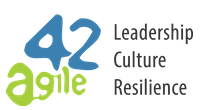How we facilitated an all-hands retrospective for 60 people in three hours
This blog post was a co-authored by Anita Siebold, Pam Clavier and Lukas Klose. It is a short version that outlines the facilitation of a retrospective for 60 or more people. You can download the corresponding ‘how to’ guide, which includes a more detailed step-by-step guide, a planning checklist, and a closer look at lessons learned.
Setting the scene
Picture six eager DevOps pods, four enthused technical teams, five servant leader program team members, one Agile Coach, three intense hours and lots of coffee. This perfectly describes what our all-teams retrospective looked like.
All-team retrospectives (retrospectives that are attended by multiple teams, such as those of an entire program, or even organization) can be an important opportunity to inspect and reflect on how teams work together as a team of teams. It is also a chance to practice empiricism at a program level: be transparent, inspect, and adapt. We believe that mirroring scrum ceremonies at the program level can serve as an important success factor for organizational agility.
With only three hours and a room of about 60 very talkative and eager participants, we needed to be organized, focused and engaging. Here is how we did it:
Begin with the end in mind – know your purpose
We wanted to walk away from the three hour meeting with the following:
- Three problem statements, with one or more proposed solutions (including acceptance criteria)
- A focus group (+/- 5 people and a steward) for each problem statement
The focus groups should take each of the proposed solutions, converge them into a single approach and move that approach forward until the next all-hands retro.
Breaking down the retrospective into phases
We wanted to align our facilitation with the diamond of participatory decision making: diverge, discuss, converge. With so many participants, clearly we needed to do breakout groups, of which each would diverge/discuss/converge. We planned to use multiple and recursive diamonds (see illustration).
Phase I: Setting the stage
We started out with announcing the focus of the conversation (in our case: ”how can we get to ‘shippable’ every two weeks?”), followed by an introduction of the agenda and a crash course about using the diamond of participatory decision making. The crash course was to encourage and enhance inclusive conversations in break-out groups.
Phase II: Brainstorming and shortlisting problem statements
Then we asked the participants to do the following:
- Individually brainstorm a list of issues
- In groups of nine, consolidate, prioritize, and articulate a single problem statement
- Take turns in presenting the problem statement to everyone in the room
- As a whole group, shortlist and consolidate on a maximum of three topics
Phase III: Root cause analysis and solutions
After phase II, we asked the participants to gather around the shortlisted problem statements and self-organize into groups of five. The newly formed groups are asked to do the following:
- Select one of the three problem statements
- Create a poster for the chosen problem statement and provide…
- a root cause analysis
- a proposed solution
- acceptance criteria
Once again, groups were asked to present their posters and feedback was provided by either
- writing the feedback down on a sticky and attach to poster, or
- putting a smiley sticker on the poster
Phase IV: Consolidate proposed solutions and drive implementation
At this stage, we called for a steward and a group of volunteers to take on one of the three topics. The purpose was to take this offline (in the weeks between retros), and follow up by
- Consolidating the proposed solutions into a single way forward
- Driving the adoption and implementation of the solution
Top 4 Learnings to take to your own retrospectives
Three months after the retro we had mostly good feedback, concrete actions taken and… lots of lessons learned. Here are some recommendations:
#1) Be very clear about the topic – When we presented the question to frame the conversation, not everyone was on the same page about what “shippable” meant. We cut the discussion about this short to stay on schedule, but this possibly affected the engagement and maturity of the subsequent conversations. Our take-away was that the focus of the conversation needs to be crystal clear. If it is even slightly ambiguous, it can become a big time-back-hole.
#2) Test your PA system ahead of time – The venue did provide us with a PA system, but we did not test it ahead of time. Once the meeting started we could not use it because the volume button was well hidden in a closet. Now as facilitators we could project our voices, so we initially thought – not a big deal, but when participants started to share their views it was sometimes very difficult to hear them. At the end we found the volume button, but it costed us some time.
#3) Define acceptance criteria early on – Acceptance criteria can be a powerful technique to avoid misunderstandings and ambiguity. We found that defining the acceptance criteria earlier than later could really improve the applicability of the proposed solutions.
#4) Provide support after the retro – Provide visibility and product ownership and Scrum Master support to focus groups in the weeks after the retrospective.
This blog article is a short version that outlines the facilitation of a retrospective for 60 or more people. The corresponding ‘how to’ guide includes a more detailed step-by-step guide, a planning checklist, and a closer look at lessons learned.

